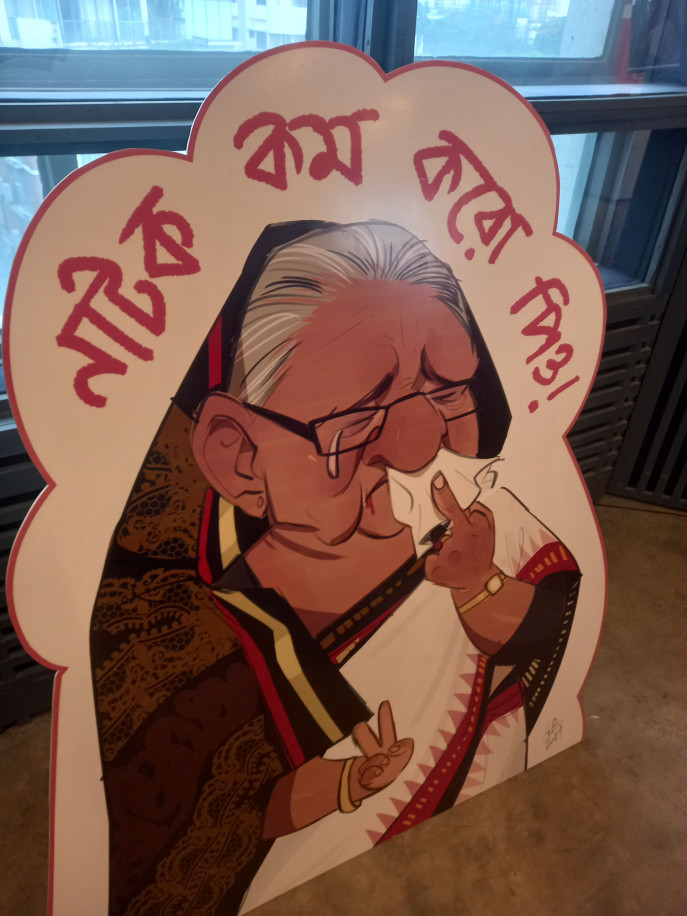Rebellion through cartoons is not a new phenomenon. Even when there was severe reluctance to express opinions, some cartoonists took risks to draw rebellious cartoons. However, these instances were rare. Then came an unprecedented event. The whole country was awakened by the student movement against inequality. From the early days of this movement, cartoonists picked up their colored pencils and brushes, drawing a series of incendiary cartoons. These caricatures provided the voice for ordinary people at that time.
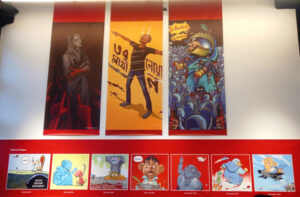
The calendar says it’s Bhadra (a Bengali month). The sky agrees too, with its mix of clouds and sunshine. Who knows when it will rain! Consequently, with the fear of drizzle, I reached Panthapath. I had to go to the DrikPath building, better known in the city as the Drik Gallery. A special exhibition is underway there, and like thousands of others, I was eager to attend it.
The event’s poster had been circulating on Facebook for several days. ‘Rebellion in Cartoons’ was the title. The name itself was enough to understand what it was about. Starting from August 16, this joint exhibition by the Bangladesh Cartoonist Network, Drik, and e-ARKEY ran from 3 PM to 8 PM. From the very first moment of the first day, the 8th floor of the DrikPath building was filled with visitors!
Rebellion through cartoons is a long-standing practice. Even when there was severe reluctance to express opinions, some cartoonists took risks to draw rebellious cartoons. These instances were rare. Then came an unprecedented event. The student movement against inequality sparked an awakening across the country. From the early days of this movement, cartoonists picked up their colored pencils and brushes, drawing one fiery cartoon after another. These caricatures became the voice of ordinary people at that time. The ‘Rebellion in Cartoons’ exhibition is centered around the cartoons used during that movement.
At 3 PM, upon arriving at DrikPath, there was a huge line in front of the elevator. Upon reaching the 8th floor, it was another push. Even before the event started, there was no room to stand in the gallery! If you stood in one place, you would actually get pushed around. The majority were Gen-Z, but there were also many from other generations. From young to old, everyone came to witness this moment in history.
Around the walls, were rows of printed cartoons. Long banners displayed fiery caricatures. As soon as you enter, on the right side, a large poster of the event is hung. Not just cartoons, the exhibition also includes various displays commemorating the July Revolution. The famous dialogue from the film ‘Heroic Raja’, ‘Dori Dhore Maro Taan, Raja Hobe Khaan Khaan’, was widely used in the anti-autocratic movement. To highlight this, a rope is attached to a mural of the autocrat, allowing visitors to pull the rope and take pictures.
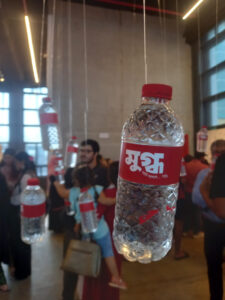
Hossne Ara Raki, a student at Brac University, brought her younger brother to the exhibition. She was quite impressed by the entire setup. She said she had shared some of these cartoons on her Facebook before. Seeing all of them together was a great experience for her. “I really liked the whole idea of having all the cartoons together. These were a significant tool in the movement,” said Raki.
On one side of the exhibition, bottles of water hung by strings with just one word written on them: Mughda (Mesmerized). On July 18, Mughda, a student at Bangladesh University of Professionals, was distributing water during the movement and was shot dead in the same procession. His words, ‘Does anyone need water? Water’ moved the entire nation. These bottles are kept to honor his memory.
The exhibition doesn’t have a somber background score; instead, fiery rap songs from the days of the movement continuously play. On one side, television screens constantly show news from each day of the July Revolution. There are two separate canvases for visitors where they can write their slogans.
Rafsan Rudro came with his college friends. He went to the canvas to write something. Up close, I saw he had written, ‘Patria o Muerte’, which means ‘Homeland or Death.’ This phrase was used by revolutionary Che Guevara in a speech at the United Nations and was widely used on social media during the July movement.
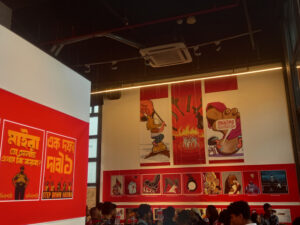
I spoke with the curator of the exhibition, ASM Rezaur Rahman. He revealed that they had selected around 150 cartoons from those drawn during the movement for this exhibition. He mentioned that it wasn’t possible to include every cartoon published during the movement. However, the displayed cartoons would transport us back to that fiery period of the student movement.
“The whole event is youth-oriented. The cartoons drawn by young people have energized the public. Now that the movement has ended, this cartoon exhibition, in a way, is a celebration,” said Rezaur Rahman. He added that ‘Rebellion in Cartoons’ is the most popular exhibition at Drik Gallery. “The medium of cartoons is a great area of public interest. Its connection with the people is very quick. People are coming, enjoying, and, in a sense, recalling the memories of the movement. Every day hundreds of people visit. This is the most attended exhibition we’ve ever had.
In contemporary times, when political cartoons are mentioned, Mehdi Haq’s name comes up first. He believes that the stagnation in political caricatures due to the autocratic government has now been broken. He sees the emergence of young cartoonists as a very positive development. He said, “What happened this time (with cartoons) is unprecedented, a big deal. The most significant aspect is the involvement of young people. This is very positive. I believe this trend will continue.”
Mehdi Haq also thinks that those who had not drawn political cartoons for various reasons will now start doing so, and newspapers will once again give importance to cartoons. “I was worried that young people might stop drawing. This event has dispelled that fear. Another thing is the huge number of visitors, which is also unprecedented,” he said. He believes that this marks the beginning of a new era for political cartoons. However, newspapers need to step up.
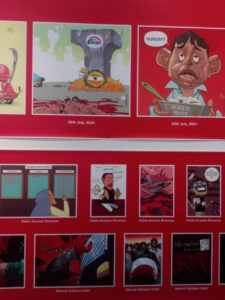
‘Rebellion in Cartoons’ features over a dozen cartoons by popular young cartoonist Mahtab Rashid. This Dhaka University Fine Arts student shared that many have drawn cartoons over the past years, but there was fear. Due to self-censorship, people had to draw carefully. When a crisis arose and people’s backs were against the wall, and they saw people dying in the streets, that self-censorship no longer worked. No one was afraid to draw anymore.
“Even those who do not draw cartoons but work in other arts or visual media have been inspired by this. The participation in the exhibition is very high. On Fridays and Saturdays, there was no room to enter. The crowd was more than Drik or us had anticipated! Even on a working day yesterday, there was a lot of crowd. This both delights and excites,” said Mahtab.
At the entrance to the exhibition, there is a small stall selling various items related to the exhibition. Under the supervision of e-ARKEY, items like cartoon-themed T-shirts, notebooks, tote bags, and posters are for sale. Posters are priced at 10 Taka. T-shirts are 450 Taka, notebooks are 350 Taka and tote bags are also available for 350 Taka. Additionally, three items can be bought together for 799 Taka.
Volunteer Hasan Mahmud reported that the sales are so high that many couldn’t buy due to the crowd. The posters sold out within the first two days, but new posters will be available soon.
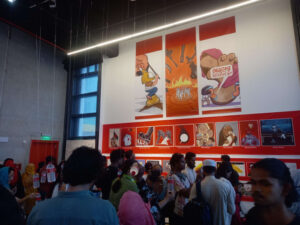
Faruk Hasan, a bank official, expressed his amazement after seeing the entire setup. He said, “There was a time when many of us couldn’t write anything. Each cartoon at that time spoke a thousand words. Even though we couldn’t share them, we saw the youth doing so. This conveyed many unspoken words.”
Simu Naser, head of e-ARKEY, informed The Business Standard that the exhibition features 175 drawings by 82 cartoonists from the July Revolution. The organizers have around 550 cartoons. They will soon release a compilation from e-ARKEY.
If you visit the ‘Rebellion in Cartoons’ exhibition, the predominance of red in the gallery will remind you of those blood-stained days. When the air was filled with cries of despair and protest. Youngblood fought for their rights, and autocracy was ousted. The exhibition will run until August 23, at Level 8 of the DrikPath building on Panthapath, from 3 PM to 8 PM. Visiting the exhibition, you too can reminisce about those turbulent days and pay tribute to the martyrs of the July Revolution.



